Quality Monitoring of Biodiesel and Diesel/Biodiesel Blends: A Comparison between Benchtop FT-NIR versus a Portable Miniaturized NIR Spectroscopic Analysis
Abstract
:1. Introduction
2. Materials and Methods
2.1. Sample Preparation for the Detection and Quantification of Contaminants in Biodiesel and of Biodiesel in Diesel/Biodiesel Blends
2.2. Infrared Spectroscopy
2.3. Spectra Preprocessing and Processing Methods
3. Results and Discussion
3.1. FT-NIR Spectroscopy of Biodiesel Contaminants
3.2. FT-NIR Spectroscopy of Biodiesel in Diesel (DPB)
3.3. nirU of Biodiesel Contaminants
3.4. nirU Spectroscopy of Biodiesel in Diesel (DPB)
4. Conclusions
Author Contributions
Funding
Data Availability Statement
Conflicts of Interest
Appendix A
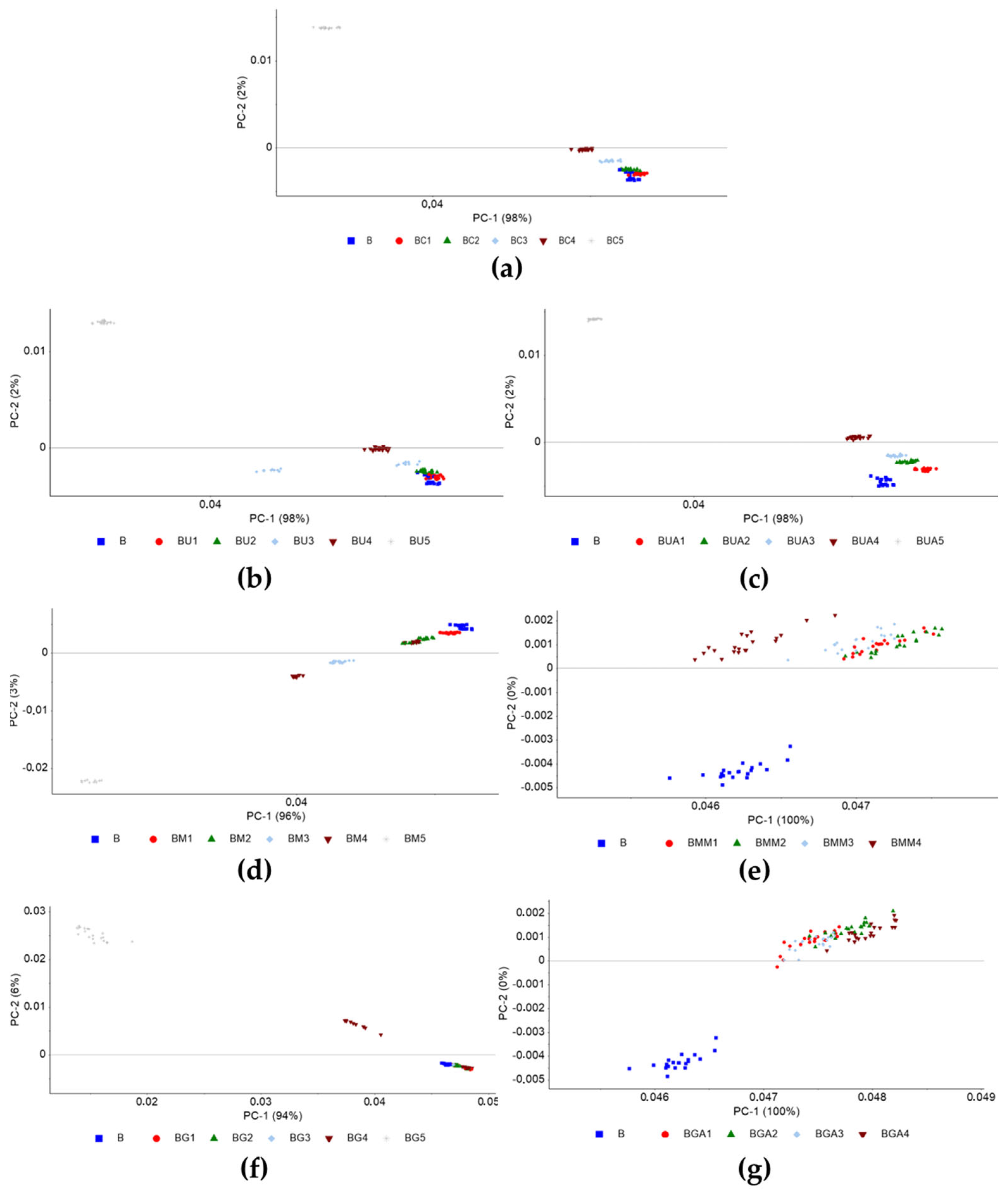
| Blend | Preprocessing Method | None | Base Corr | Base Corr + Max Norm |
|---|---|---|---|---|
| BC | Latent variables | 4 | 5 | 2 |
| R2 calibration | 0.62 | 0.61 | 0.58 | |
| R2 external validation | 0.56 | 0.57 | 0.59 | |
| RMSEC/% (w/w) | 3.57 | 3.62 | 3.73 | |
| RMSEP/% (w/w) | 3.67 | 3.64 | 3.57 | |
| BU | Latent variables | 6 | 5 | 5 |
| R2 calibration | 0.56 | 0.56 | 0.56 | |
| R2 external validation | 0.59 | 0.58 | 0.58 | |
| RMSEC/% (w/w) | 3.27 | 3.27 | 3.27 | |
| RMSEP/% (w/w) | 3.25 | 3.27 | 3.30 | |
| BUA | Latent variables | 4 | 4 | 5 |
| R2 calibration | 0.71 | 0.69 | 0.74 | |
| R2 external validation | 0.81 | 0.74 | 0.67 | |
| RMSEC/% (w/w) | 0.11 | 0.11 | 2.45 | |
| RMSEP/% (w/w) | 0.09 | 0.11 | 3.04 | |
| BM | Latent variables | 6 | 6 | 5 |
| R2 calibration | 0.61 | 0.62 | 0.61 | |
| R2 external validation | 0.57 | 0.58 | 0.57 | |
| RMSEC/% (w/w) | 3.08 | 3.04 | 3.07 | |
| RMSEP/% (w/w) | 3.02 | 2.97 | 3.02 | |
| BMM | Latent variables | 2 | 2 | 4 |
| R2 calibration | 0.53 | 0.50 | 0.54 | |
| R2 external validation | 0.36 | 0.36 | 0.28 | |
| RMSEC/% (w/w) | 2.45 × 10−3 | 2.51 × 10−3 | 0.24 | |
| RMSEP/% (w/w) | 2.30 × 10−3 | 2.30 × 10−3 | 0.24 | |
| BG | Latent variables | 6 | 6 | 4 |
| R2 calibration | 0.69 | 0.71 | 0.72 | |
| R2 external validation | 0.66 | 0.68 | 0.70 | |
| RMSEC/% (w/w) | 2.59 | 2.52 | 2.47 | |
| RMSEP/% (w/w) | 3.28 | 3.19 | 3.11 | |
| BGA | Latent variables | 4 | 4 | 3 |
| R2 calibration | 0.80 | 0.83 | 0.83 | |
| R2 external validation | 0.82 | 0.79 | 0.81 | |
| RMSEC/% (w/w) | 1.49 × 10−3 | 1.41 × 10−3 | 0.14 | |
| RMSEP/% (w/w) | 1.33 × 10−3 | 1.43 × 10−3 | 0.13 |

References
- Bozbas, K. Biodiesel as an alternative motor fuel: Production and policies in the European Union. Renew. Sustain. Energy Rev. 2005, 12, 542–552. [Google Scholar] [CrossRef]
- Ferrero, G.O.; Faba, E.M.S.; Rickert, A.A.; Eimer, G.A. Alternatives to rethink tomorrow: Biodiesel production from residual and non-edible oils using biocatalyst technology. Renew. Sustain. Energy Rev. 2019, 150, 128–135. [Google Scholar] [CrossRef]
- Verma, P.; Sharma, M.; Dwivedi, G. Impact of alcohol on biodiesel production and properties. Renew. Sustain. Energy Rev. 2016, 56, 319–333. [Google Scholar] [CrossRef]
- Gelinski, E.K.; Hamerski, F.; Corazza, M.L.; Santos, A.F. Biodiesel Synthesis Monitoring using Near Infrared Spectroscopy. Open Chem. Eng. J. 2018, 12, 95–110. [Google Scholar] [CrossRef]
- European Biodiesel Board (EBB), about Biodiesel. European Union. Available online: https://ebb-eu.org/about-biodiesel/ (accessed on 11 August 2022).
- Zhang, W.-B. Review on analysis of biodiesel with infrared spectroscopy. Renew. Sustain. Energy Rev. 2012, 16, 6048–6058. [Google Scholar] [CrossRef]
- Christopher, L.P.; Kumar, H.; Zambare, V.P. Enzymatic biodiesel: Challenges and opportunities. Appl. Energy 2014, 119, 497–520. [Google Scholar] [CrossRef]
- Alternative Fuels Data Center, Diesel Vehicles Using Biodiesel. U.S. Department of Energy. Available online: https://afdc.energy.gov/vehicles/diesel.html (accessed on 11 August 2022).
- European Standard EN 14214; CEN—European Committee for Standardization: Brussels, Belgium, 2003.
- Pontes, M.J.C.; Pereira, C.F.; Pimentel, M.F.; Vasconcelos, F.V.C.; Silva, A.G.B. Screening analysis to detect adulteration in diesel/biodiesel blends using near-infrared spectrometry and multivariate classification. Talanta 2011, 85, 2159–2165. [Google Scholar] [CrossRef] [Green Version]
- Corgozinho, C.N.; Pasa, V.M.; Barbeira, P.J. Determination of residual oil in diesel oil by spectrofluorimetric and chemometric analysis. Talanta 2008, 76, 479–484. [Google Scholar] [CrossRef]
- López-Fernández, J.; Moya, D.; Benaiges, M.D.; Valero, F.; Alcalà, M. Near Infrared Spectroscopy: A useful technique for inline monitoring of the enzyme catalyzed biosynthesis of third-generation biodiesel from waste cooking oil. Fuel 2022, 319, Article 123794. [Google Scholar] [CrossRef]
- Sales, K.C.; Rosa, F.; Sampaio, P.N.; Fonseca, L.P.; Lopes, M.B.; Calado, C.R. In Situ Near-Infrared (NIR) Versus High-Throughput Mid-Infrared (MIR) Spectroscopy to Monitor Biopharmaceutical Production. Appl. Spectrosc. 2014, 69, 760–772. [Google Scholar] [CrossRef]
- Mazivila, S.J. Trends of non-destructive analytical methods for identification of biodiesel feedstock in diesel-biodiesel blend according to European Commission Directive 2012/0288/EC and detecting diesel-biodiesel blend adulteration: A brief review. Talanta 2018, 180, 239–247. [Google Scholar] [CrossRef] [PubMed]
- Baptista, P.; Felizardo, P.; Menezes, J.C.; Correia, M.J.N. Multivariate near infrared spectroscopy models for predicting the methyl esters content in biodiesel. Anal. Chim. Acta 2008, 607, 153–159. [Google Scholar] [CrossRef]
- Lira, L.F.B.; Vasconcelos, F.V.C.; Pereira, C.F.; Paim, A.P.S.; Stragevitch, L.; Pimentel, M.F. Prediction of properties of diesel/biodiesel blends by infrared spectroscopy and multivariate calibration. Fuel 2010, 89, 405–409. [Google Scholar] [CrossRef]
- Canha, N.; Felizardo, P.; Menezes, J.C.; Correia, M.J.N. Multivariate near infrared spectroscopy models for predicting the oxidative stability of biodiesel: Effect of antioxidants addition. Fuel 2012, 97, 352–357. [Google Scholar] [CrossRef]
- Canha, N.; Felizardo, P.; Correia, M.J.N. Controlling the Oxidative Stability of Biodiesel Using Oils or Biodiesel Blending or Antioxidants Addition. Environ. Prog. Sustain. Energy 2017, 37, 1031–1040. [Google Scholar] [CrossRef]
- Baptista, P.; Felizardo, P.; Menezes, J.C.; Correia, M.J.N. Monitoring the quality of oils for biodiesel production using multivariate near infrared spectroscopy models. J. Near Infrared Spectrosc. 2008, 16, 445–454. [Google Scholar] [CrossRef]
- Felizardo, P.; Baptista, P.; Uva, M.S.; Menezes, J.C.; Correia, M.J.N. Monitoring biodiesel fuel quality by near infrared spectroscopy. J. Near Infrared Spectrosc. 2007, 15, 97–105. [Google Scholar] [CrossRef]
- Du, Q.; Zhu, M.; Shi, T.; Luo, X.; Gan, B.; Tang, L.; Chen, Y. Adulteration detection of corn oil, rapeseed oil and sunflower oil in camellia oil by in situ diffuse reflectance near-infrared spectroscopy and chemometrics. Food Control 2021, 121, Article 107577. [Google Scholar] [CrossRef]
- Correia, R.M.; Domingos, E.; Cáo, V.M.; Araujo, B.R.; Sena, S.; Pinheiro, L.U.; Fontes, A.M.; Aquino, L.F.M.; Ferreira, E.C.; Filgueiras, P.R.; et al. Portable near infrared spectroscopy applied to fuel quality control. Talanta 2018, 176, 26–33. [Google Scholar] [CrossRef]
- Paiva, E.M.; Rohwedder, J.J.R.; Pasquini, C.; Pimentel, M.F.; Pereira, C.F. Quantification of biodiesel and adulteration with vegetable oils in diesel/biodiesel blends using portable near-infrared spectrometer. Fuel 2015, 160, 57–63. [Google Scholar] [CrossRef]
- Fernandes, D.D.S.; Gomes, A.A.; Costa, G.B.; Silva, G.W.B.; Véras, G. Determination of biodiesel content in biodiesel/diesel blends using NIR and visible spectroscopy with variable selection. Talanta 2011, 87, 30–34. [Google Scholar] [CrossRef] [PubMed] [Green Version]
- Silva, G.W.B.; Gomes, A.A.; Silva, P.; Costa, G.B.; Fernandes, D.D.S.; Fontes, M.M.; Veras, G. Biodiesel/Diesel Blends Classification with Respect to Base Oil Using NIR Spectrometry and Chemometrics Tools. J. Am. Oil Chem. Soc. 2012, 89, 1165–1171. [Google Scholar] [CrossRef]
- Alves, J.C.L.; Poppi, R.J. Biodiesel content determination in diesel fuel blends using near infrared (NIR) spectroscopy and support vector machines (SVM). Talanta 2012, 104, 155–161. [Google Scholar] [CrossRef] [Green Version]
- Pimentel, M.F.; Ribeiro, G.M.; Cruz, R.S.; Stragevitch, L.; Filho, J.G.A.P.; Teixeira, L.S. Determination of biodiesel content when blended with mineral diesel fuel using infrared spectroscopy and multivariate calibration. Microchem. J. 2006, 82, 201–206. [Google Scholar] [CrossRef]
- Felizardo, P.; Baptista, P.; Menezes, J.C.; Correia, M.J.N. Multivariate near infrared spectroscopy models for predicting methanol and water content in biodiesel. Anal. Chim. Acta 2007, 595, 107–113. [Google Scholar] [CrossRef] [PubMed]
- Alves, J.C.L.; Poppi, R.J. Quantification of conventional and advanced biofuels contents in diesel fuel blends using near-infrared spectroscopy and multivariate calibration. Fuel 2016, 165, 379–388. [Google Scholar] [CrossRef]
- Silva, N.C.; Cavalcanti, C.J.; Honorato, F.A.; Amigo, J.M.; Pimentel, M.F. Standardization from a benchtop to a handheld NIR spectrometer using mathematically mixed NIR spectra to determine fuel quality parameters. Anal. Chim. Acta 2017, 954, 32–42. [Google Scholar] [CrossRef]
- Richard, R.; Dubreuil, B.; Thiebaud-Roux, S.; Prat, L. On-line monitoring of the transesterification reaction carried out in microreactors using near infrared spectroscopy. Fuel 2013, 104, 318–325. [Google Scholar] [CrossRef] [Green Version]
- Killner, M.H.; Rohwedder, J.J.; Pasquini, C. A PLS regression model using NIR spectroscopy for on-line monitoring of the biodiesel production reaction. Fuel 2011, 90, 3268–3273. [Google Scholar] [CrossRef] [Green Version]
- Sales, R.; Silva, N.C.; Silva, J.P.; França, H.H.; Pimentel, M.F.; Stragevitch, L. Handheld near-infrared spectrometer for on-line monitoring of biodiesel production in a continuous process. Fuel 2019, 254, Article 115680. [Google Scholar] [CrossRef]
- Lima, S.M.; Silva, B.F.A.; Pontes, D.V.; Pereira, C.F.; Stragevitch, L.; Pimentel, M.F. In-line monitoring of the transesterification reactions for biodiesel production using NIR spectroscopy. Fuel 2014, 115, 46–53. [Google Scholar] [CrossRef] [Green Version]
- Alcalà, M.; Blanco, M.; Moyano, D.; Broad, N.W.; O’Brien, N.; Friedrich, D.; Pfeiffer, F.; Siesler, H.W. Qualitative and quantitative pharmaceutical analysis with a novel hand-held miniature near infrared spectrometer. J. Near Infrared Spectrosc. 2014, 21, 445–457. [Google Scholar] [CrossRef] [Green Version]
- Kranenburg, R.F.; Weesepoel, Y.; Alewijn, M.; Sap, S.; Arisz, P.W.; Esch, A.; Keizers, P.H.; Asten, A.C. The importance of wavelength selection in on-scene identification of drugs of abuse with portable near-infrared spectroscopy. Forensic Chem. 2022, 30, Article 100437. [Google Scholar] [CrossRef]
- Beć, D.K.B.; Grabska, D.J.; Huck, P.C.W. Principles and Applications of Miniaturized Near-Infrared (NIR) Spectrometers. Chemistry 2021, 27, 1514–1532. [Google Scholar] [CrossRef] [PubMed]
- Beć, K.B.; Grabska, J.; Huck, C.W. Miniaturized NIR Spectroscopy in Food Analysis and Quality Control: Promises, Challenges, and Perspectives. Foods 2022, 11, 1465. [Google Scholar] [CrossRef]
- Lutz, O.; Bonn, G.; Rode, B.; Huck, C. Reproducible quantification of ethanol in gasoline via a costumized near-infrared spectrometer. Anal. Chim. Acta 2014, 826, 61–68. [Google Scholar] [CrossRef] [PubMed]
- Zimmermann, B.; Kohler, A. Optimizing Savitzky–Golay Parameters for Improving Spectral Resolution and Quantification in Infrared Spectroscopy. Appl. Spectrosc. 2013, 67, 892–902. [Google Scholar] [CrossRef] [Green Version]
- Zeaiter, M.; Rutledge, D. 3.04—Preprocessing Methods. In Comprehensive Chemometrics; Brown, S.D., Tauler, R., Walczak, B., Eds.; Elsevier: Amsterdam, The Netherlands, 2009; Volume 3, pp. 121–231. [Google Scholar]
- Oliveira, F.C.; Brandão, C.R.; Ramalho, H.F.; Costa, L.A.; Suarez, P.A.; Rubim, J.C. Adulteration of diesel/biodiesel blends by vegetable oil as determined by Fourier transform (FT) near infrared spectrometry and FT-Raman spectroscopy. Anal. Chim. Acta 2007, 587, 194–199. [Google Scholar] [CrossRef]

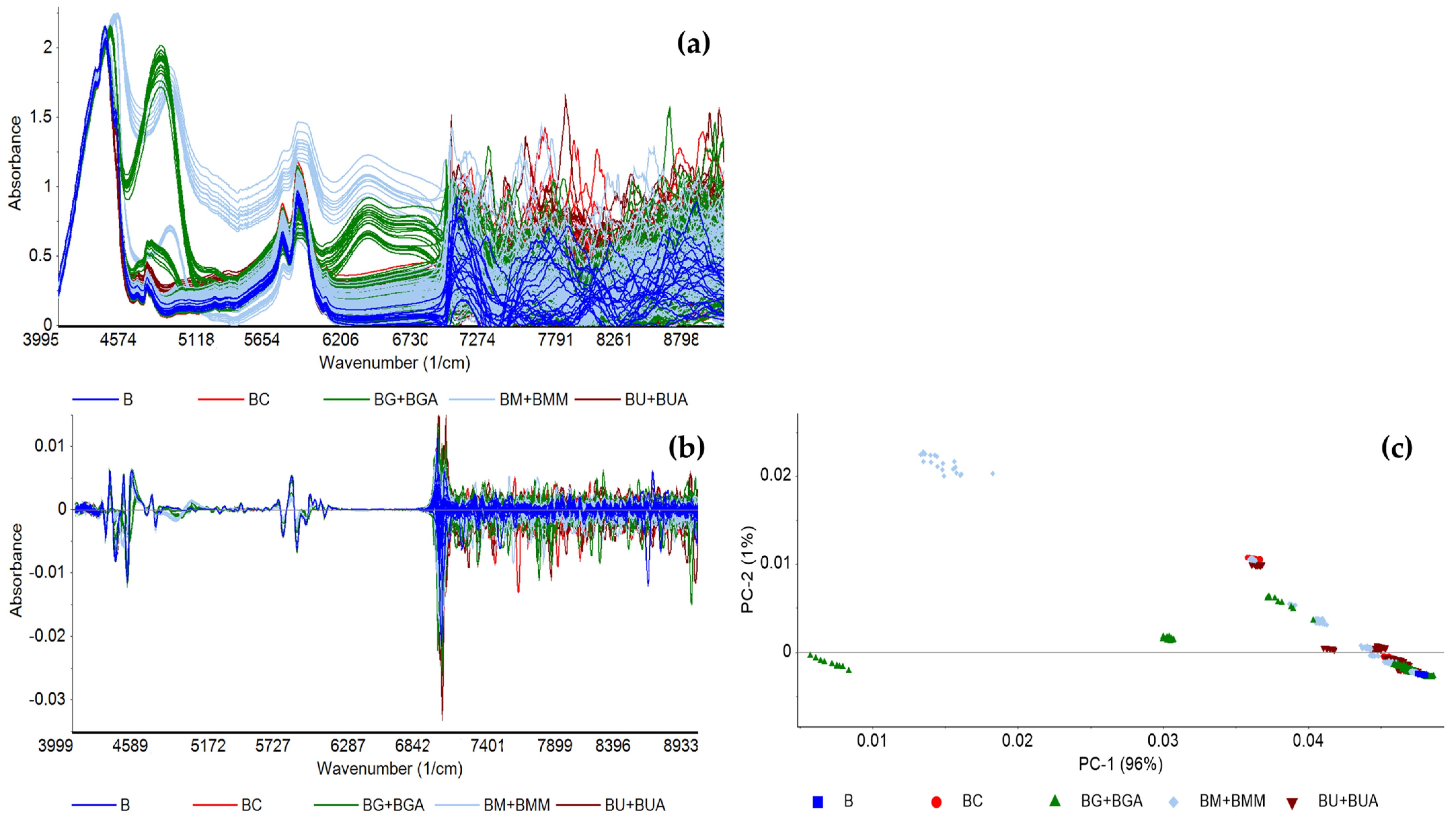
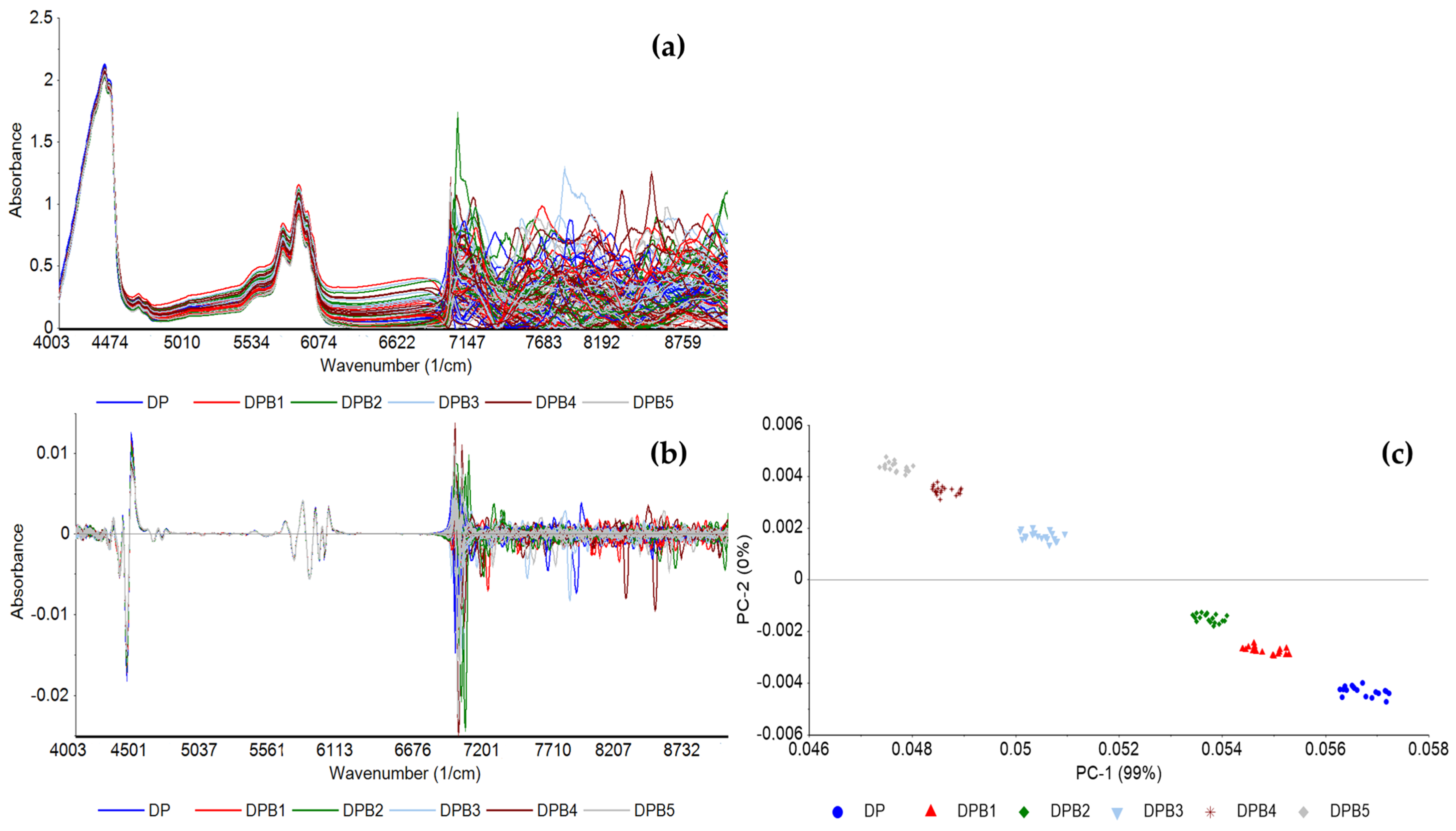
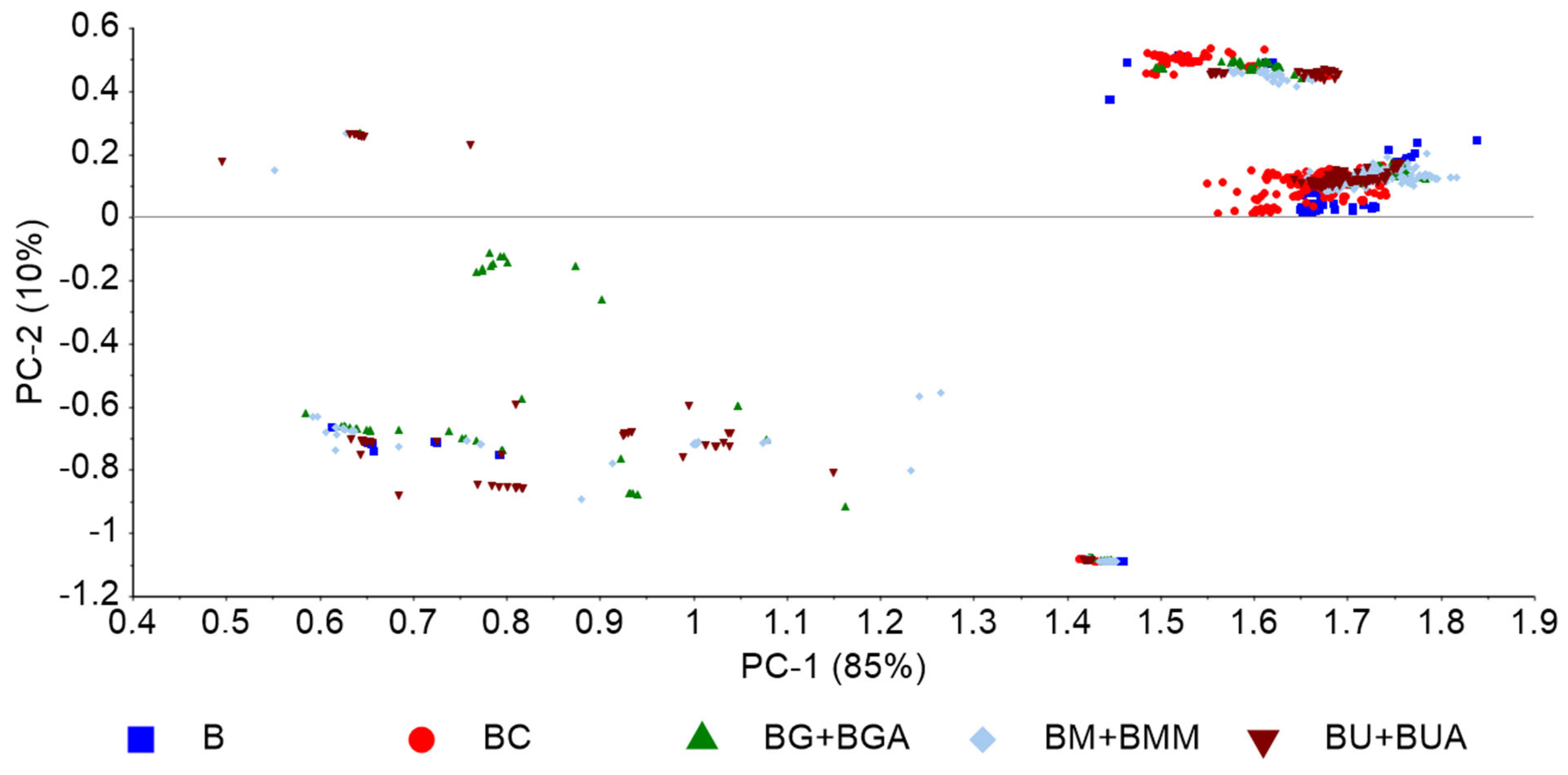
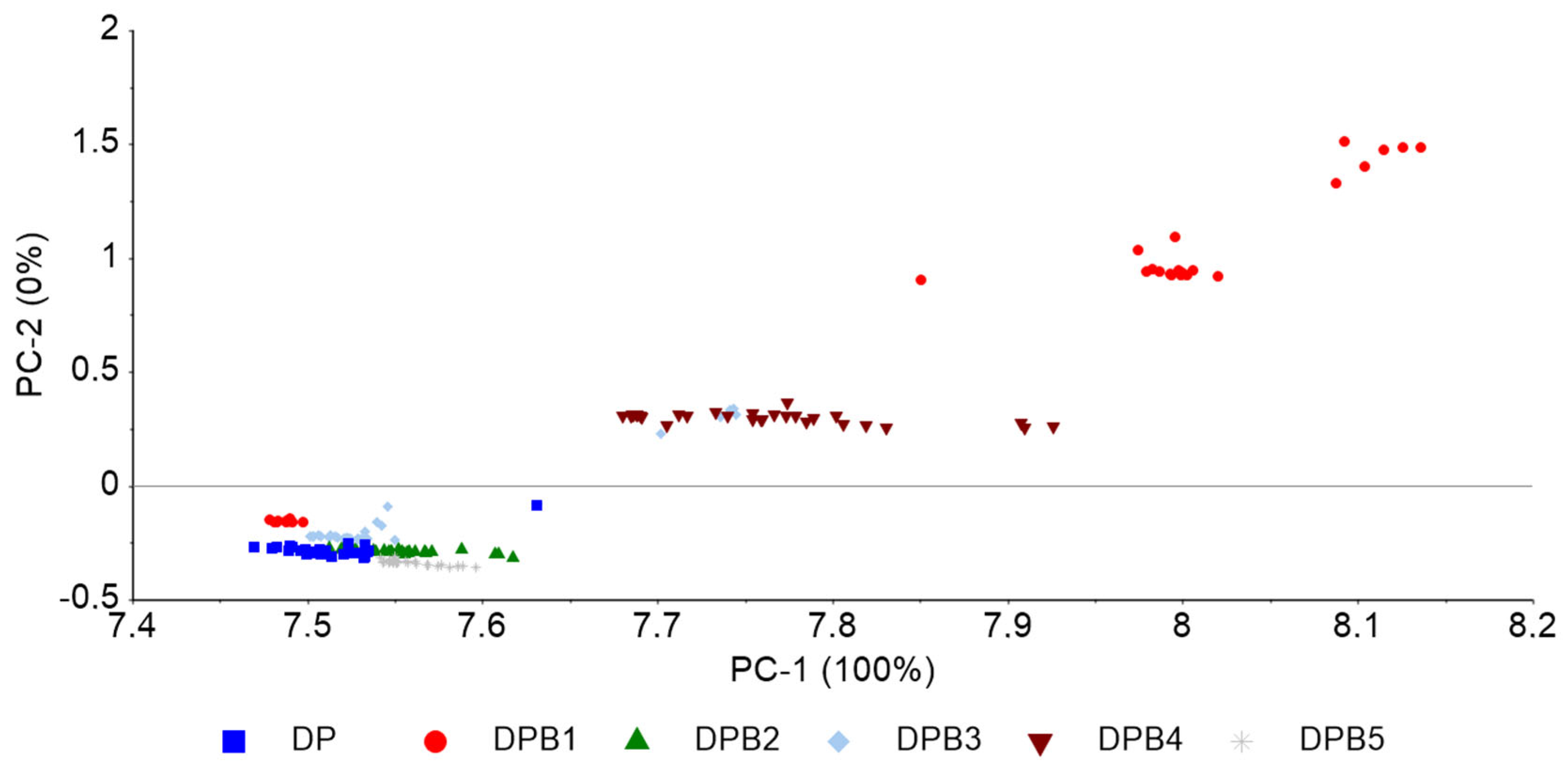
| Aim of Analysis | Type of Analysis | R2 | RMSEP | Ref |
|---|---|---|---|---|
| VO content—Soybean oil | 0.986 | 3.40% (w/w) | [19] | |
| VO content—Palm oil | 0.996 | 2.50% (w/w) | ||
| VO content—Rapeseed oil | 0.977 | 5.40% (w/w) | ||
| VO content | FT | 0.992 | 0.30% (v/v) | [23] |
| Miniaturized | 0.973 | 0.46% (v/v) | ||
| Contaminant content—Water | 0.903 | 111 mg/kg | [19] | |
| Contaminant content—Water | 0.986 | 87 mg/kg | [20] | |
| Contaminant content—Methanol | 0.996 | 73 mg/kg | ||
| Contaminant content—Methanol | 0.993 | 61 mg/kg | [28] | |
| Biodiesel content in diesel/biodiesel blends | Miniaturized | 0.998 | 1.80 wt% | [22] |
| FT | 0.994 | 0.26% (v/v) | [23] | |
| Portable and micro | 0.988 | 0.32% (v/v) | ||
| Off-line transmission | 0.9922 | 0.662% (v/v) | [24] | |
| Off-line reflection | 0.999 | 0.83% (v/v) | [26] | |
| FT Off-line transmission | 0.994 | 0.18% (v/v) | [27] | |
| 0.999 | 0.24% | [29] | ||
| FT | 0.96 | 0.4% | [30] | |
| Miniaturized | 0.88 | 1.01% | ||
| Parameter—Density | FT Online transmission (a flow cell) | 0.990 | 0.56 kg/m3 | [16] |
| Parameter—S content | 0.930 | 0.02% (w/w) | ||
| Parameter—Distillation point T50% | 0.880 | 2.12 °C | ||
| Parameter—Distillation point T85% | 0.940 | 3.37 °C | ||
| Parameter—Oxidative stability | 0.910 | 1.28 h | [17] | |
| Parameter—Iodine value | 0.991 | 3.1 g I2/100 g | [19] | |
| Parameter—Acid number | 0.856 | 0.22 mg KOH/g | ||
| Reaction monitoring—Ester content | 0.989 | 2.1% | [12] | |
| 0.996 | 2.0% | |||
| Reaction monitoring—Ethyl ester content | FT | 0.985 | 4.10% | [31] |
| Reaction monitoring—Glycerides conversion to methyl esters | - | 0.74% of conversion | [32] | |
| Reaction monitoring—Alkyl ester content | Miniaturized | 0.79 | 2.15 wt% | [33] |
| Reaction monitoring—Methyl ester content | FT | 0.98 | 2.25% | [34] |
| Methyl ester content | 0.895 | 0.9% | [15] |
| Contaminant Concentration/% (w/w) | ||||||
|---|---|---|---|---|---|---|
| Blends | Description | 1 | 2 | 3 | 4 | 5 |
| BC | Biodiesel with RSO | 1.25 | 2.5 | 5 | 10 | 50 |
| BU | Biodiesel with UCO (Type 1) | 1.25 | 2.5 | 5 | 10 | 50 |
| BUA | Biodiesel with UCO (Type 2) | 1.25 | 2.5 | 5 | 10 | 50 |
| BM | Biodiesel with methanol | 1.25 | 2.5 | 5 | 10 | 50 |
| BMM | Biodiesel with methanol | 0.08 | 0.16 | 0.313 | 0.625 | - |
| BG | Biodiesel with glycerol | 1.25 | 2.5 | 5 | 10 | 50 |
| BGA | Biodiesel with glycerol | 0.08 | 0.16 | 0.313 | 0.625 | - |
| Biodiesel Concentration/% (v/v) | ||||||
| 1 | 2 | 3 | 4 | 5 | ||
| DPB | Diesel with biodiesel | 2.5 | 5 | 10 | 12.5 | 15 |
| Preprocessing Method | #Components | BC + BU + BUA + BM + BMM + BG + BGA | BC + BU + BUA | BC | BU + BUA | BM + BMM | BG + BGA |
|---|---|---|---|---|---|---|---|
| SV2 | 2 | 38 | 83 | 78 | 79 | 78 | 57 |
| 3 | 40 | 83 | 79 | 79 | 84 | 76 | |
| 4 | 65 | 78 | 71 | 79 | 77 | 64 | |
| 5 | 68 | 80 | 74 | 79 | 89 | 73 | |
| AN | 2 | 26 | 84 | 80 | 72 | 89 | 65 |
| 3 | 68 | 95 | 80 | 79 | 91 | 66 | |
| 4 | 75 | 79 | 84 | 73 | 81 | 61 | |
| 5 | 75 | 80 | 84 | 75 | 91 | 78 | |
| SV2 + AN | 2 | 56 | 48 | 32 | 43 | 49 | 62 |
| 3 | 50 | 78 | 79 | 78 | 66 | 61 | |
| 4 | 67 | 81 | 70 | 78 | 64 | 66 | |
| 5 | 68 | 78 | 74 | 76 | 89 | 73 |
| Blend | Preprocessing Method | None | MC | Base Corr | SV2 |
|---|---|---|---|---|---|
| BC 0–10% (w/w) | Latent variables | 4 | 3 | 5 | 4 |
| R2 calibration | 0.99 | 0.98 | 0.98 | 0.99 | |
| R2 external validation | 0.99 | 0.98 | 0.97 | 0.99 | |
| RMSEC/% (w/w) | 0.43 | 0.40 | 0.79 | 0.48 | |
| RMSEP/% (w/w) | 0.56 | 0.49 | 0.71 | 0.68 | |
| BU 0–10% (w/w) | Latent variables | 3 | 5 | 4 | 3 |
| R2 calibration | 0.97 | 0.99 | 0.98 | 0.98 | |
| R2 external validation | 0.98 | 0.99 | 0.96 | 0.99 | |
| RMSEC/% (w/w) | 0.80 | 0.32 | 0.74 | 0.69 | |
| RMSEP/% (w/w) | 0.75 | 0.33 | 0.84 | 0.70 | |
| BUA 0–10% (w/w) | Latent variables | 3 | 3 | 5 | 3 |
| R2 calibration | 0.99 | 0.99 | 0.99 | 0.99 | |
| R2 external validation | 0.99 | 0.99 | 0.99 | 0.99 | |
| RMSEC/% (w/w) | 0.58 | 0.36 | 0.48 | 0.59 | |
| RMSEP/% (w/w) | 0.60 | 0.33 | 0.55 | 0.67 | |
| BM 0–10% (w/w) | Latent variables | 3 | 7 | 5 | 2 |
| R2 calibration | 0.86 | 0.90 | 0.82 | 0.87 | |
| R2 external validation | 0.73 | 0.41 | 0.83 | 0.73 | |
| RMSEC/% (w/w) | 1.70 | 1.03 | 2.21 | 1.64 | |
| RMSEP/% (w/w) | 3.24 | 3.24 | 2.09 | 3.27 | |
| BMM 0–0.625% (w/w) | Latent variables | 4 | 3 | 5 | 4 |
| R2 calibration | 0.99 | 0.98 | 0.98 | 0.99 | |
| R2 external validation | 0.99 | 0.98 | 0.99 | 0.99 | |
| RMSEC/% (w/w) | 0.03 | 0.03 | 0.04 | 0.03 | |
| RMSEP/% (w/w) | 0.03 | 0.03 | 0.04 | 0.03 | |
| BG 0–10% (w/w) | Latent variables | 6 | 7 | 7 | 5 |
| R2 calibration | 0.97 | 0.95 | 0.97 | 0.95 | |
| R2 external validation | 0.97 | 0.94 | 0.97 | 0.92 | |
| RMSEC/% (w/w) | 0.84 | 0.74 | 0.82 | 1.20 | |
| RMSEP/% (w/w) | 0.84 | 0.86 | 1.01 | 1.33 | |
| BGA 0–0.625% (w/w) | Latent variables | 7 | 7 | 7 | 6 |
| R2 calibration | 0.98 | 0.97 | 0.96 | 0.97 | |
| R2 external validation | 0.83 | 0.84 | 0.90 | 0.72 | |
| RMSEC/% (w/w) | 0.05 | 0.04 | 0.07 | 0.06 | |
| RMSEP/% (w/w) | 0.09 | 0.08 | 0.10 | 0.11 |
| Preprocessing Method | None | MC | Base Corr | SV2 |
|---|---|---|---|---|
| Latent variables | 3 | 3 | 4 | 2 |
| R2 calibration | 0.99 | 0.99 | 0.99 | 0.99 |
| R2 external validation | 0.99 | 0.99 | 0.99 | 0.99 |
| RMSEC/% (v/v) | 0.10 | 0.43 | 0.73 | 0.41 |
| RMSEP/% (v/v) | 0.10 | 0.47 | 0.76 | 0.44 |
| Preprocessing Method | #Components | BC + BU + BUA + BM + BMM + BG + BGA | BC + BU + BUA | BC | BU + BUA | BM + BMM | BG + BGA |
|---|---|---|---|---|---|---|---|
| Unprocessed | 2 | 29 | 55 | 48 | 68 | 67 | 68 |
| 3 | 35 | 58 | 50 | 59 | 48 | 67 | |
| 4 | 46 | 66 | 72 | 60 | 53 | 66 | |
| 5 | 75 | 70 | 84 | 49 | 52 | 76 | |
| Baseline correction | 2 | 31 | 55 | 49 | 67 | 47 | 67 |
| 3 | 48 | 54 | 44 | 58 | 45 | 67 | |
| 4 | 48 | 66 | 72 | 55 | 53 | 73 | |
| 5 | 75 | 72 | 86 | 54 | 57 | 76 | |
| Area normalization | 2 | 29 | 56 | 48 | 68 | 58 | 58 |
| 3 | 72 | 61 | 47 | 71 | 58 | 55 | |
| 4 | 76 | 66 | 73 | 71 | 53 | 79 | |
| 5 | 78 | 66 | 74 | 71 | 57 | 77 | |
| Baseline correction and maximum normalization | 2 | 71 | 55 | 48 | 68 | 50 | 51 |
| 3 | 72 | 55 | 45 | 71 | 47 | 51 | |
| 4 | 68 | 66 | 61 | 71 | 45 | 69 | |
| 5 | 69 | 69 | 78 | 74 | 57 | 78 | |
| Baseline correction and MSC | 2 | 47 | 51 | 45 | 40 | 56 | 71 |
| 3 | 66 | 56 | 60 | 40 | 55 | 44 | |
| 4 | 71 | 49 | 59 | 61 | 68 | 41 |
| Preprocessing Method | None | Base Corr | Base Corr + Max Norm |
|---|---|---|---|
| Latent variables | 4 | 5 | 3 |
| R2 calibration | 0.70 | 0.72 | 0.67 |
| R2 external validation | 0.68 | 0.69 | 0.71 |
| RMSEC/% (v/v) | 5.02 | 4.91 | 5.34 |
| RMSEP/% (v/v) | 5.41 | 5.32 | 5.19 |
Disclaimer/Publisher’s Note: The statements, opinions and data contained in all publications are solely those of the individual author(s) and contributor(s) and not of MDPI and/or the editor(s). MDPI and/or the editor(s) disclaim responsibility for any injury to people or property resulting from any ideas, methods, instructions or products referred to in the content. |
© 2023 by the authors. Licensee MDPI, Basel, Switzerland. This article is an open access article distributed under the terms and conditions of the Creative Commons Attribution (CC BY) license (https://creativecommons.org/licenses/by/4.0/).
Share and Cite
Monteiro, L.L.; Zoio, P.; Carvalho, B.B.; Fonseca, L.P.; Calado, C.R.C. Quality Monitoring of Biodiesel and Diesel/Biodiesel Blends: A Comparison between Benchtop FT-NIR versus a Portable Miniaturized NIR Spectroscopic Analysis. Processes 2023, 11, 1071. https://doi.org/10.3390/pr11041071
Monteiro LL, Zoio P, Carvalho BB, Fonseca LP, Calado CRC. Quality Monitoring of Biodiesel and Diesel/Biodiesel Blends: A Comparison between Benchtop FT-NIR versus a Portable Miniaturized NIR Spectroscopic Analysis. Processes. 2023; 11(4):1071. https://doi.org/10.3390/pr11041071
Chicago/Turabian StyleMonteiro, Luísa L., Paulo Zoio, Bernardo B. Carvalho, Luís P. Fonseca, and Cecília R. C. Calado. 2023. "Quality Monitoring of Biodiesel and Diesel/Biodiesel Blends: A Comparison between Benchtop FT-NIR versus a Portable Miniaturized NIR Spectroscopic Analysis" Processes 11, no. 4: 1071. https://doi.org/10.3390/pr11041071
APA StyleMonteiro, L. L., Zoio, P., Carvalho, B. B., Fonseca, L. P., & Calado, C. R. C. (2023). Quality Monitoring of Biodiesel and Diesel/Biodiesel Blends: A Comparison between Benchtop FT-NIR versus a Portable Miniaturized NIR Spectroscopic Analysis. Processes, 11(4), 1071. https://doi.org/10.3390/pr11041071










